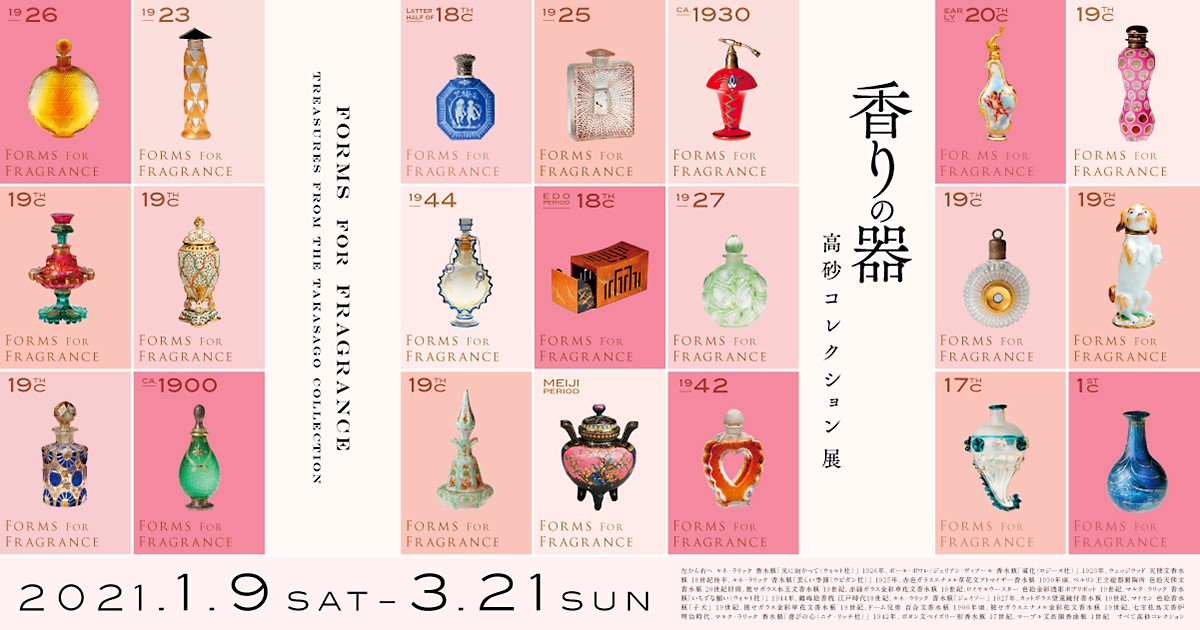Forms for Fragrance –Treasures from the Takasago Collection

To those who wish to visit the Forms for Fragrance –Treasures from the Takasago Collection
Admission to the Forms for Fragrance: Treasures from the Takasago Collection exhibition does not require a prior reservation.However, during busy times, visitors may be asked to wait or be assigned a specific time block for admission.Once all time blocks for the day have been filled, we will be unable to accept any more visitors.The photography corner will be closed from Saturday, March 13th to Sunday, March 21st to avoid congestion at the museum.
General Information
- Dates
- January. 9 - March. 21, 2021
- Hours
- 10 a.m. - 6 p.m. (Admittance until 5:30 p.m.)
* Open until 8 p.m. (admittance until 7:30 p.m.) on Feb. 5 and Mar. 5
【Notice】
You can enter the " Forms for Fragrance: Treasures from the Takasago Collection" exhibition without reservation. We will limit the number of visitors in the exhibition room as measures to prevent the spread of COVID-19 infection. After reaching the limit, we will issue a numbered ticket and specify the admission time. In addition, we will be closed at night on Feb.5(Friday) and Mar.5(Friday).
- Closed
- Wednesdays
- Admission
- Adults: ¥1000
Visitors aged 65 or over carrying proof of age: ¥900
Students (College): ¥700
Students (High / Middle school): ¥500
Admission is free for children in primary school and younger.
Admission is free for disability passbook holders and up to one accompanying adult.
- Organizers
- Panasonic Shiodome Museum of Art, The Tokyo Shimbun
- Supporters
- Embassy of France in Tokyo / Institut français du Japon, Minato City Board of Education
- Special Cooperation
- Takasago International Corporation
- Planning cooperation
- Okamura Printing Industries Co., Ltd., Kyuryudo Art-Publishing Co., Ltd., and Artone Co., Ltd.
Exhibition overview
The works in this exhibition range from fragrant oil containers from the ancient Orient to gorgeous porcelain and glass perfume bottles that added luster to modern European lifestyles. They also include utterly luxurious lacquer, porcelain, and metal incense burners and other implements associated with the traditional Japanese art of appreciating incense. The exhibition presents about 240 items carefully selected from the Takasago Collection, the superb collection of works of art related to perfumes and fragrances built by Takasago International Corporation over the span of many years. The history of fragrances and their containers is, it is said, as old as humanity. Experiencing this collection provides the ideal opportunity to savor the profound depths of the history and culture associated with fragrances old and new, from East and West. At the exhibition in Tokyo, additional works on loan from art museums in Japan will also be on display. These include portraits of aristocratic women that evoke perfumes, together with works that epitomize Art Deco. This exhibition offers an exceptional opportunity for visitors to experience directly the close association of containers for fragrances with painting and design from the same period.








